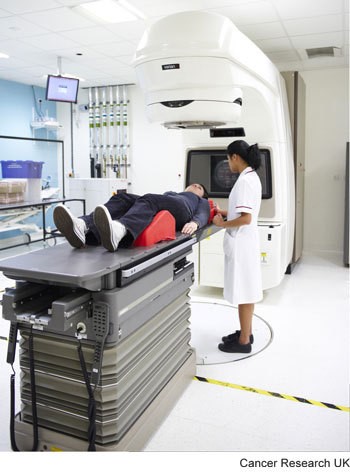Radiotherapy for pain in the bone
Secondary bone cancer weakens bones and can be very painful. This can make them more likely to  if you have a fall. Sometimes they might even break during everyday activities.
if you have a fall. Sometimes they might even break during everyday activities.
Radiotherapy to control bone pain
You might have radiotherapy to control pain from secondary bone cancer. This might be with other types of treatment. But depends on the type of cancer you have.
Radiotherapy can help prevent your bones from fracturing. It can also help to prevent new painful areas developing.
Having this treatment might slow down the cancer and give you a better quality of life for a longer time. But it won't cure your cancer. Treatment that aims to relieve your symptoms is called palliative radiotherapy.
How you have treatment
Both external and internal radiotherapy can help with bone pain.
More rarely you might have hemibody irradiation. This is a type of external radiotherapy.
External beam radiotherapy
External radiotherapy is the most common type of treatment for secondary bone cancer.
Before you start your treatment you have a specialised CT planning scan. This helps the treatment team plan exactly where to give the radiotherapy. You might also need to have a plastic mould made to keep you still during the treatment sessions.
The position that you are in for this scan is the same position that you will be in for your treatment. Let a member of the team know if you are struggling to maintain this position. It can be more difficult to change once you have had the scan.
To have the treatment you lie on the radiotherapy couch. The therapeutic radiographers will help you to get into the right position.

Once you are in the right position the radiographers leave you alone in the room. This is so they are not exposed to radiation. You will be alone for a few minutes. They can see and hear you the whole time.
It is important that you keep still and breathe normally. Sometimes there may be a delay in starting the radiotherapy. This is due to the radiographers taking an x-ray before treatment to check your position.
You can't feel the radiotherapy. It doesn’t hurt but you may find it uncomfortable to lie in position during the treatment. This is because the radiotherapy couch can be quite hard. Ask a member of the health care team if you can take a painkiller half an hour beforehand if you think it might help.
You might have a single treatment or a series of daily treatment sessions, Monday to Friday for up to 2 weeks.
Hemibody irradiation
You might have hemibody irradiation if you have a lot of areas of secondary bone cancer.
Hemibody irradiation involves having external radiotherapy to the whole body. You have radiotherapy to the upper body. And then 2 to 4 weeks later you have treatment to your lower body.
To have this treatment your bone marrow needs to be working well. It is an uncommon treatment these days.
Internal radiotherapy with radiotherapy liquids (radioisotopes)
Your doctor might suggest internal radiotherapy with radioactive liquids for bone cancer that has spread from the prostate. You might have radioactive strontium or radium 223.
You have them as an injection. The radioactive liquid is picked up by the cancer cells in the bone.
The radiation from the injection only lasts a few days in your body. It is only a small amount but can help to control bone pain.
Side effects
The side effects with this treatment are usually mild. Radiotherapy for bone pain aims to relieve symptoms and so the amount of radiotherapy you receive is usually low. Different treatments cause different side effects.
The side effects depend on which part of the body has treatment. This type of treatment usually has few side effects including:
- feeling tired
- your skin may get red and itchy in the treatment area
- treatment can cause a flare up of pain for 1 or 2 days and you may need painkillers to help
- feeling sick if you are having treatment to your ribs, your stomach area, your pelvic area or your skull – your doctor or nurse can give you
anti emetics  and taking them an hour before your treatment might help
and taking them an hour before your treatment might help - having diarrhoea with treatment to your hips (pelvis), or bowel area – you can have medicines to reduce diarrhoea
The side effects tend to come on gradually as you go through your treatment course. They may last for a week or two after the treatment has finished.
With hemibody irradiation, you are likely to feel sick. To prevent this, your doctor can give you anti sickness medicines and steroids before your treatment.
The treatment might also slow the production of blood cells by your bone marrow. So you might not have enough red blood cells (anaemic) and have an increased risk of infection. This is temporary.
Your doctors will keep an eye on your blood cell levels when you have your check ups.
There are very few side effects with strontium 89 treatment or radium 223 therapy.
You have some radioactivity in your body for a while after the treatment. The amount is extremely small and gets lower each day.
Your doctor will let you know if there are any safety guidelines you need to follow after your treatment. How long you have to follow these depends on the dose of treatment that you had.



